NOTE: Several readers have let me know that this blog post only had photos without any words so I’m posting it again.
A walk in the woods at this time of year is a journey of discovery. So many things are there in miniature, waiting to be spotted if you take the time to look closely. Trilliums, for example. Not many are yet in bloom but they are beginning to open up as the days grow warmer.
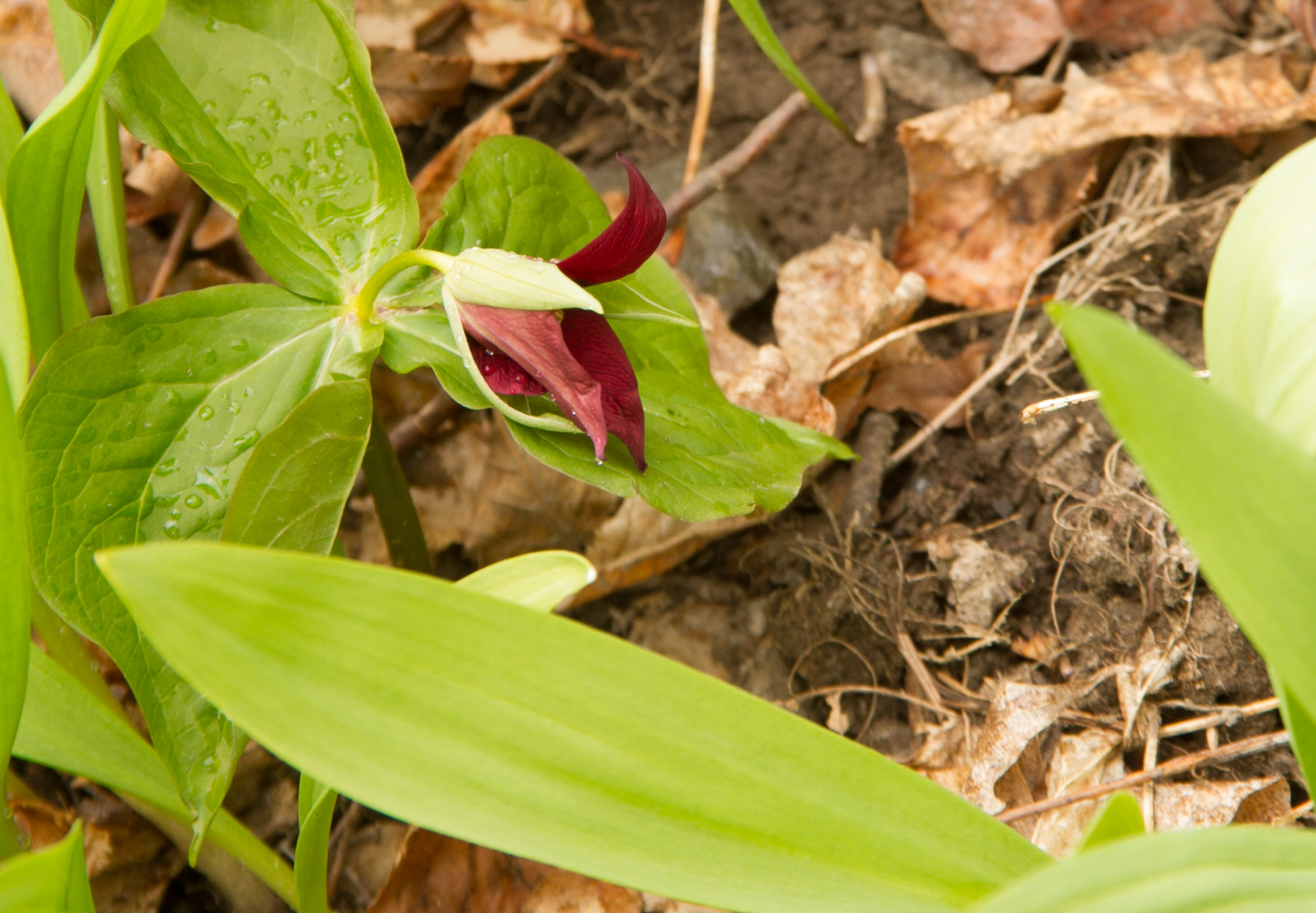
Red trilliums (Trillium erectum) go by many common names. Wake Robin, Birthroot, Indian Shamrock and Stinking Benjamin are some of them.
Most trout lilies are still hiding in the leaves that cover the woodland floor but their speckled foliage makes them fairly easy to spot.

Trout lilies (Erythronium americanum ) get their name from the spots on their leaves. Other common names are adder’s tongue and dogtooth violet. I didn’t spot any trout lilies in bloom, but the blossoms will come soon with more warm weather.
Ferns beginning to unfurl are everywhere.
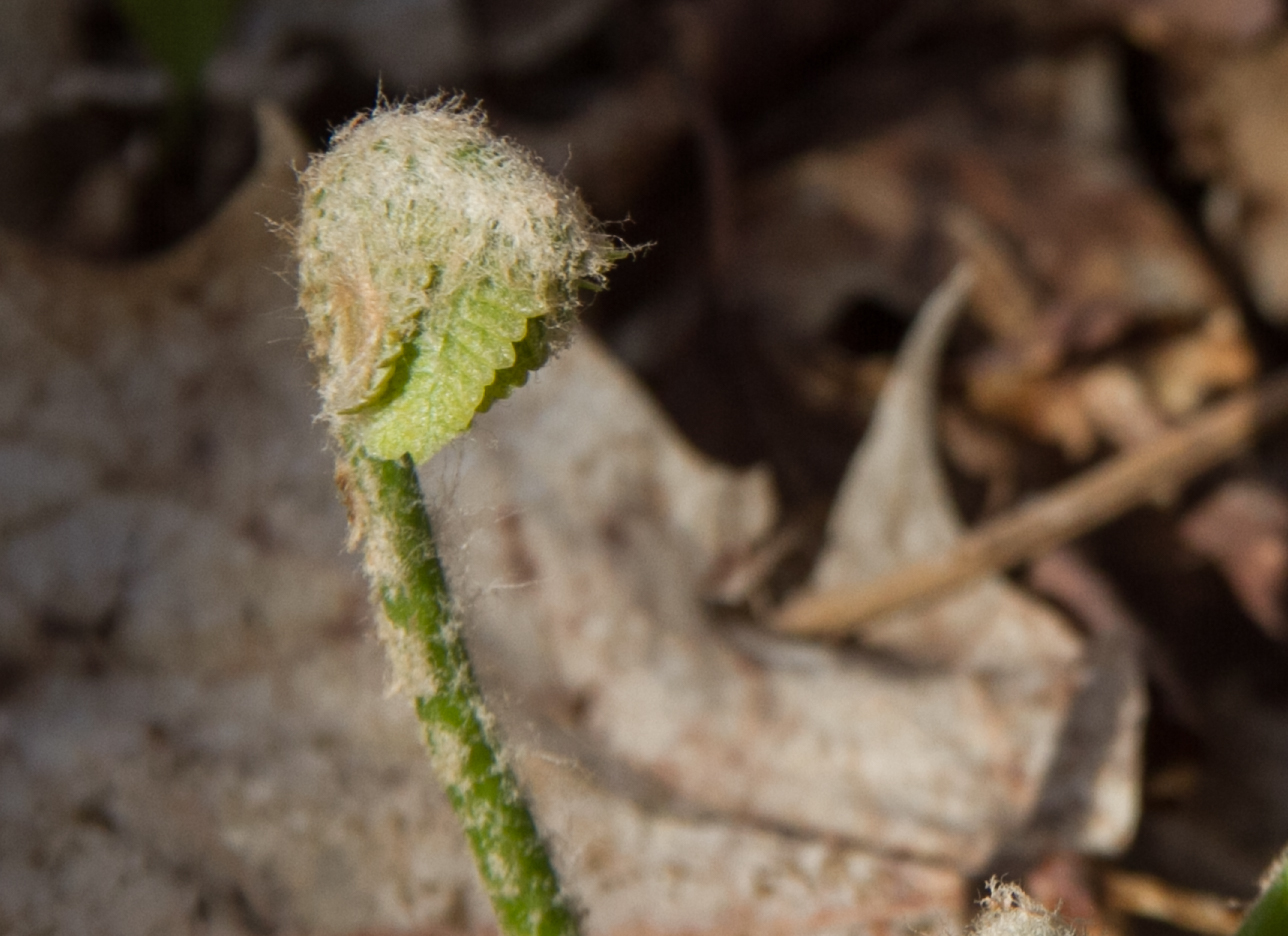
I can’t identify this shy fern with certainty since most identification sites show the fully grown plant. I’m sure someone else can name it.
Less obvious is this distinctively coloured wildflower. I saw it in different stages of development, depending where it was growing, whether in a more open or a more sheltered spot.

Dark maroon leaves still tightly closed remind me of clasped hands. The coloration should help to identify this wildflower. What is it?
Nearby on another plant, the fingers of the leaves had started to stretch up to the sun.

The dark almost-leaves stand out against the green foliage behind them. It looks as if the leaves will be delicate and lacy.
I couldn’t identify this plant, even after one of my companions spotted one in bloom. However, thanks to an on-line request, I now know that this is northern blue cohosh (Caulophyllum giganteum). Wikipedia tells me that it blooms about two weeks earlier than its near name sake, blue cohosh (Caulophyllum thalictroides), and that the latter has more abundant flowers.

The flower isn’t showy but I was glad to see it in bloom. Thanks to Paul Koloszar and Kim Eierman for helping me identify it.
Taking time to look closely was part of the pleasure of my walk in the woods. But the best part was what I came to see — a forest of ramps, or wild garlic.

A forest floor covered in bright green leaves is a sight to behold. The smell when the leaves are crushed is garlicky beyond description. And deliciously overwhelming.
Wild garlic grows prolifically in the forests in Quebec. In our area of the Eastern Townships, and perhaps more generally, it prefers moist maple woods — and Quebec has lots of those.
The plant, Allium tricoccum, goes by several names: wild garlic, wild leeks and ramps are most common; in French it is ail sauvage or ail des bois. It is the first wild vegetable of spring, and it is delicious, with a sweet, garlicky flavour that becomes sweeter and more mellow when cooked.
It is also versatile and can be roasted, grilled, sautéed, pickled and made into pesto. Its versatility and flavour, added to the fact that it grows wild, mean that in many places it has been over-harvested. The plants are slow growers, taking five to seven years to mature. In Quebec, where commercial harvesting was banned in 1995, the leaves generally appear in April, then die back as the days lengthen and temperatures rise. Flowers bloom in July or early August on top of a thin leafless stalk, and the seeds that eventually fall to the ground are slow to germinate.

This seed head shows the shape of the flower of allium tricoccum. Only mature plants flower and set seed.
In Quebec personal collecting is permitted but is limited to 5% of a patch. This means that my friends and I dug carefully, looking for thick patches with the large leaves that indicate the age of the plant. And since a little goes a long way with wild garlic, restraint was the order of the day.

Digging isn’t difficult but you do need to put your back into it.
The plants resemble spring onions but are more beautiful, with slender green leaves and a purple stem that runs up the leaves like a seam.
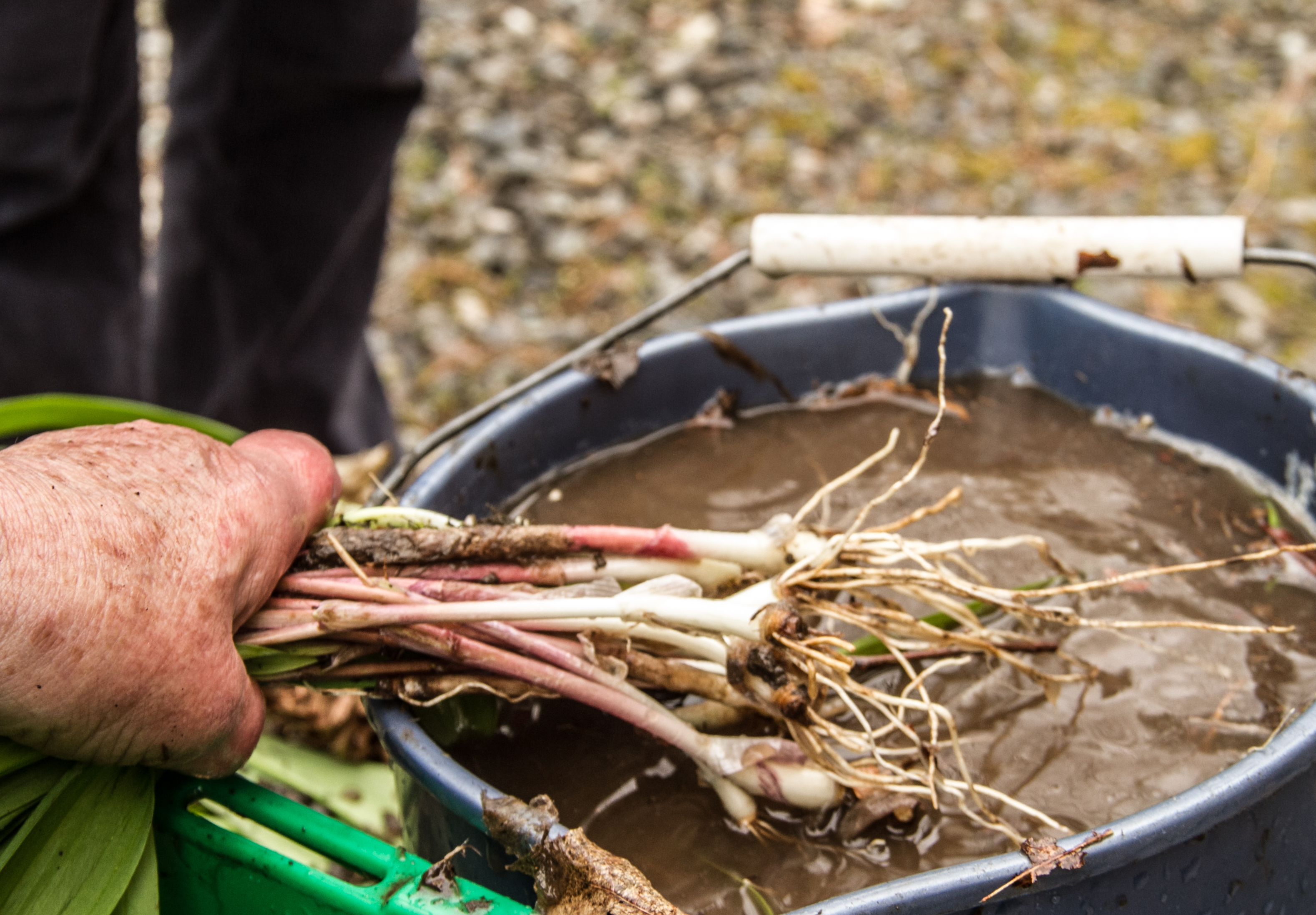
Cleaning ramps and preparing them for cooking is quick and easy. Wash off the dirt, carefully trim the roots and they are ready to go.
The variety that grows in North America, Allium tricoccum, is different from the variety that is native throughout Europe and Asia. European wild garlic (Allium ursinum) gets its botanical name from the fact that brown bears, members of the genus Ursus, like the taste of the bulb. So, apparently, do wild boars. Based on the photo below that I found on-line, the leaves of Allium ursinum are broader and the flowers spikier than its North American cousin. But it has even more names: ramsons, buckrams, wild garlic, broad-leaved garlic, wood garlic, bear leek or bear’s garlic.
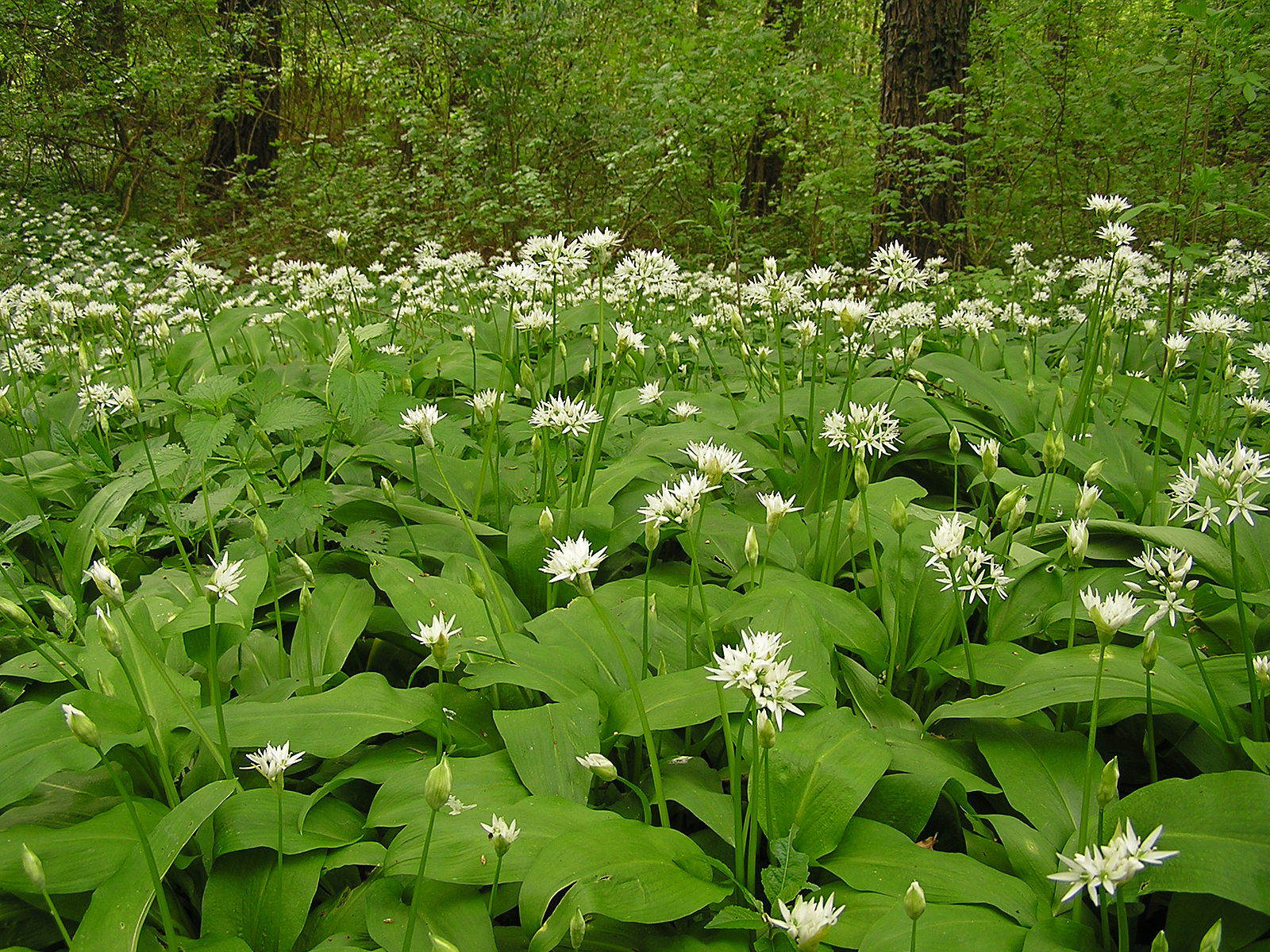
This photo found on line shows a patch of Allium ursinum. The flower is pointy, not round, and the leaves broader than the North American variety.
This was my first experience digging and cooking with ramps. It won’t be my last. Not only is wild garlic versatile and delicious, it is also growing in huge patches close to home.
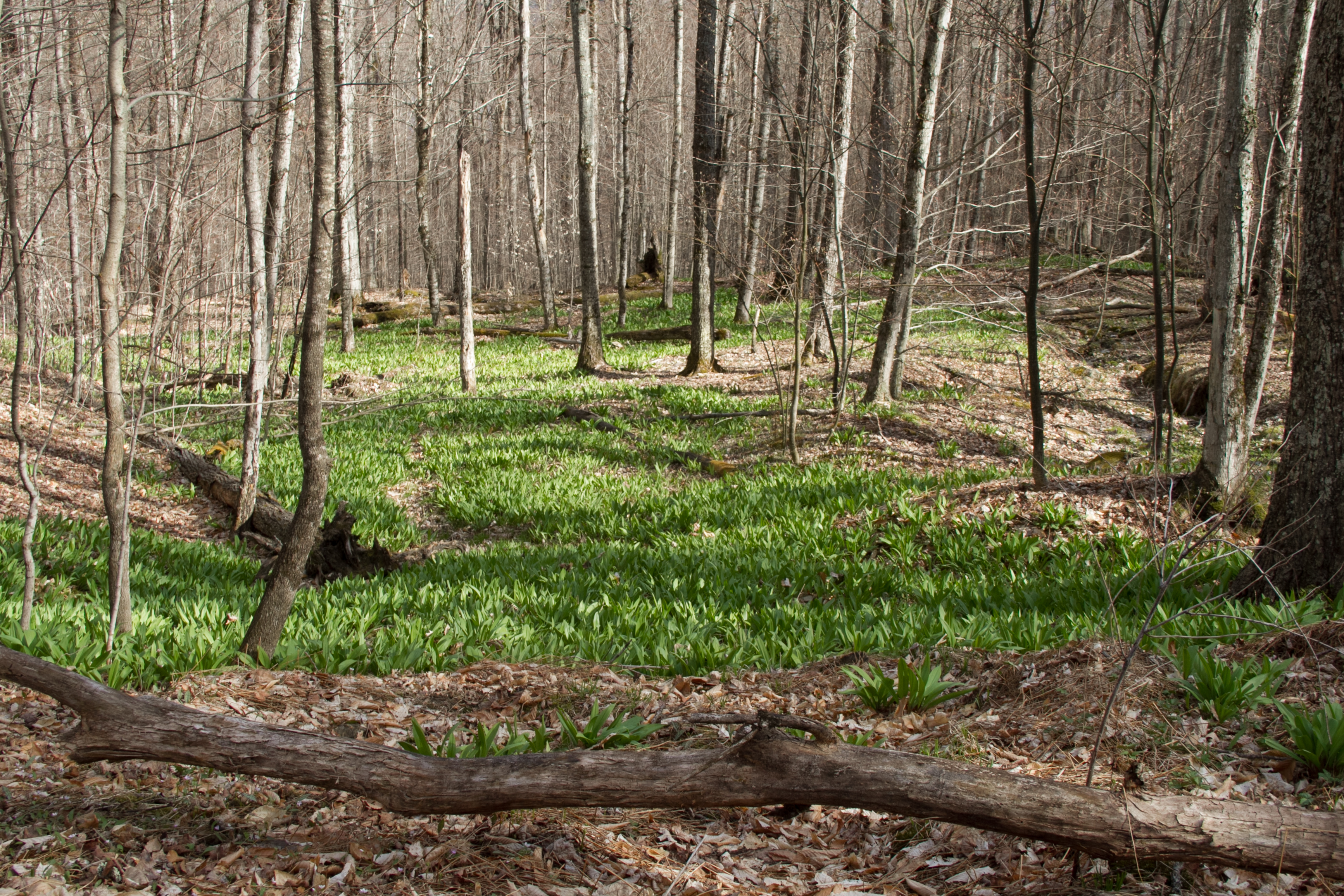
I don’t often walk in this section of the woods in spring — it is too wet. So it was a surprise to come across such a huge colony of Allium tricoccum growing wild in our woods. I will harvest it only occasionally, never taking too much at a time.
I plan to harvest our wild garlic sparingly and use it only when I want its special flavour, cooked or raw. I’ll add it to the list of wild plants we consume that include berries and mushrooms in particular.
Do you forage, eat or cook with any wild plants? Any experiences, good or bad, that you want to share?







Years ago, probably one summer when we were both home from college, my brother and I got a copy of Euell Gibbons’ Stalking the Wild Asparagus. Despite the fact that we lived in a small city, we were determined to see how many foods we could forage and eat. We couldn’t find white oak (or was it chestnut oak) trees, so we roasted and ate acorns from some other kind of oak – not very good. We found wild grapes, enough to attempt to make jelly, but somehow it came out the texture of tar. We ate it anyway.
A more successful foraging experience was on a trip to the sunshine coast, north of Vancouver. We were there in blackberry season, and we could stop our car just about anywhere and hop out and eat blackberries to our hearts’ content.
OK, now you have me going. Another amazing experience of foraged food was on a visit to Majorca years ago, also with my brother. We camped at a remote end of the island where there were abandoned fig and almond orchards. Every day we would hike down the cliffs to the beach, and on the return trip, we would gather fresh figs and almonds in our sun hats.
I forage for berries in the same way you did north of Vancouver. Some summers are better than others, and then I used to make (and still think about making) jam. Lots of seeds = lots of work. The result does not taste like tar, or have its consistency. (Probably you cooked it too long.)
The foraged food on Majorca is more exotic than I’ve ever experienced. Sounds idyllic.
(Stalking the Wild Asparagus made me think of a book our children read: The Celery Stalks at Midnight. I can’t remember if it was any good or only had a great title.)
Fiddle heads always a treat and then there is always the smelts out of your brook!
Fiddleheads take so much time and effort to clean that I rarely bother. I’ve never caught the smelts but I know lots of people do. Many I’ll give that a try.
We have a few small patches of ramps on our land. I have never seen them bloom, and I now think it’s because they aren’t old enough yet. But how did they get there? There must be a mother plant somewhere, yes? Here the trout lilies came out and bloomed before the Trillium erectum–at least this year. But the Jacks-in-the-pulpit were later than usual.
Once I saw a woodland full of wild garlic mixed with bluebells; both were in full bloom, and the garlic in full scent. This was in England, though, not in Canada. Our garlic does bloom and this year I plan to make a special point of watching for it, now that I know where it is growing.
I agree, there should be a mother plant somewhere. But it could be some distance from the patches you have.
Some trillium are blooming here, many still to come.